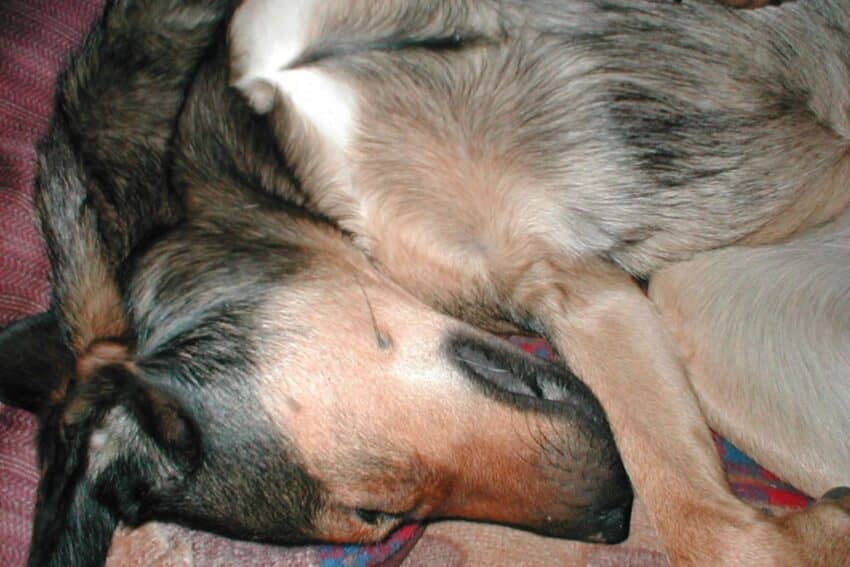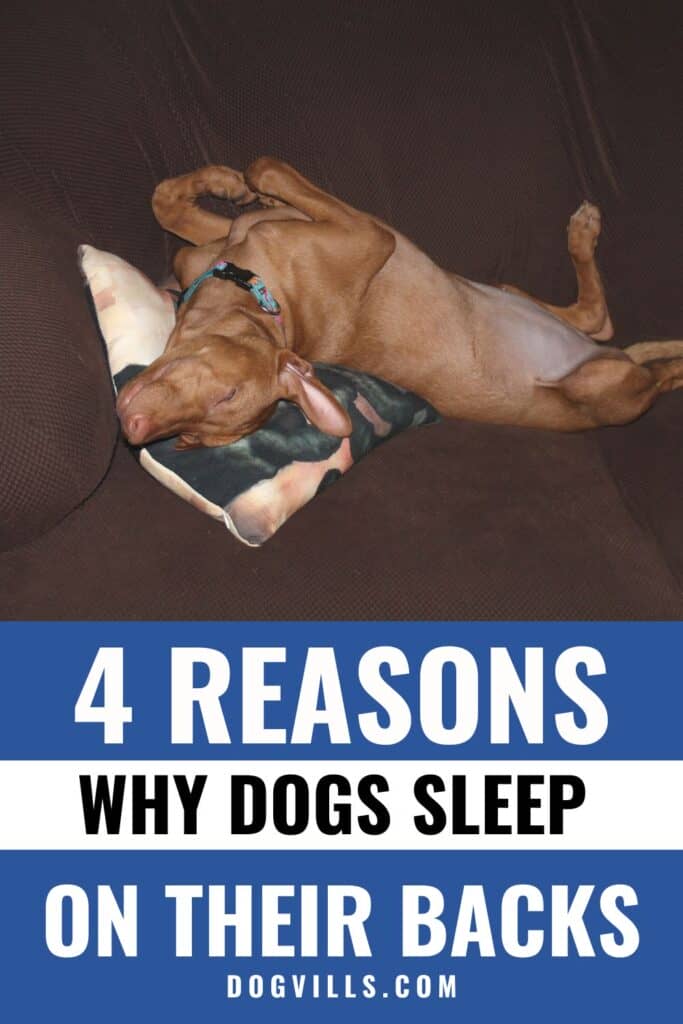Have you ever walked in to find your dog sleeping in the most adorable manner? You know the position, the one when they are on their backs? The little tummy is out and proud, the paws are up like a little, furry Tyrannosaurus Rex, and their precious head cocked to the side. It is just too adorable!
There are a lot of different sleeping positions for dogs. This particular pose is called a few different things: the dead cockroach pose (or just “roaching”), belly up, back sleeper, etc. It doesn’t matter what you call it as long as you call it cute!
But have you ever asked yourself why dogs sleep on their backs? Yes, it is so cute, but why do they do it? What makes a dog sleep with their bellies up?

Dogs Love Sleep
Dogs have sleeping preferences that can vary among them (just like humans). Some dogs may prefer curling up into a ball, lying on their sides, or burrowing under something instead. In addition, a dog’s sleeping position can be influenced by factors such as how old they are, what their health is, or even their current surroundings.
You may have noticed that your puppy or young dog used to lie on their back. As dogs get older, they may not sleep on their backs as much. Their sleep position is whatever is comfortable for them.
According to Science Direct, domestic dogs sleep an average of 10.1 hours a day. This was reported in a recent study that stated that dogs sleep between 7.7 and 16 hours daily. That is a lot of sleeping!
In addition, the study examined how dog sleep was found to be mainly polyphasic. Polyphasic sleep is sleep that is broken up into multiple times throughout the day versus a long continuous moment of sleep. This may be a reason why it seems your dog is always sleeping.
They are always sleeping! Just in short bursts all throughout the day. It would be interesting to find out how long your dog sleeps.
No matter if your dog sleeps a lot or a little, let’s explore this one sleeping position. This tummy up on their back position is super comfortable for some dogs. But it may not be for all dogs.
You may actually have a breed that doesn’t sleep much. Ever want to know what dog breeds sleep the least? Check out our article, Which Dog Breeds Sleep the Least? These Are the Top 7 Most Active Pups!
Talk to Your Vet
Before we get started it is important to note if your dog has a change in their sleeping patterns you should contact your veterinarian.
If you are ever worried about this (or any other behavior that your dog exhibits) please reach out to a professional. No question is too silly or small.
You always want to prioritize your dog’s health. And sleep patterns or even sleep positions may be an indicator of something more. So please reach out to your vet if you are curious or concerned.
4 Reasons Why Dogs Sleep on Their Backs
Now let’s get going to explore the reasons why dogs might be in this pose for sleep. Some of the reasons might surprise you. Let’s see why:
1. Hot Dog
According to the American Kennel Club (AKC), dogs can lie on their backs to sleep to help them cool off. Dogs deal with their body temperature in different ways than their human counterparts. Dog regulate their temperature through their paws, exposing their stomachs, and by panting.
Your dog having their belly to the sky may help cool them down as they sleep because they have less hair on their tummies. Even very furry dogs have more sparse hair on their stomachs. That difference in hair length and density can make a big cooling difference.
You may have heard that dogs don’t sweat. Will they do, but they perspire a little differently. As PetMD explains, most of our dog’s sweat glands are located around the foot pads.
The main way dogs cool themselves is through panting with their mouth open. This happens by having the moisture on the tongue evaporate. That panting helps our dog regulate their temperature.
There are some dog breeds, for example, brachycephalic breeds, that have restricted airways. Those are breeds like pugs, boxers, and bulldogs (think of dogs with flat faces). These types of breeds are more prone to overheating or heat stroke.
If you are ever worried about your dog being too hot here are some signs that something more could be happening. These signs are signs of heat stroke in dogs. This is a serious condition when a dog gets too hot.
Now, for the most part, dogs sleeping on their backs does not necessarily mean heat stroke. It can just mean they are cooling down while they sleep. It is similar to sleeping with a leg outside the blanket.
For puppies and dogs, lying on their back may help them cool down. It is important to note that for the most part, those brachycephalic breeds may have a harder time sleeping on their back due to their unique anatomy.

2. Getting Some Air
Speaking of anatomy, some dogs sleep on their back just for comfort. This position can offer a way to breathe deeper for some breeds. This on-the-back position allows dogs to have their face unrestricted. The dogs also have their stomach and lungs upright and uncovered.
It may not be for all dog breeds but for some, they love to have their stomach exposed and their paws up. Sighthounds in particular are fond of this “roaching” position!
Let your dog lay back and take a deep breath. We all deserve to be in a position to breathe a little easier. Literally in this case!
3. Deep Stretch
When your pooch lies on their back they are able to get a deep stretch. And we all know the rule, if your dog stretches, you MUST say “What a big stretch!” I am pretty sure it is a law.
But the health benefits of stretching our muscles are universal. There are several studies about stretching for dogs and humans. There is one study by the British Veterinary Association about the effectiveness of passive stretching on the range of motion of osteoarthritic Labrador Retrievers.
If stretching can make a difference in osteoarthritic Labs, then that health benefit can be enjoyed by others. There was significant improvement with passive stretching in just 21 days. The on-the-back sleeping position offers a passive stretch as well.
Stretching is wonderful and your dog probably feels great doing it! It helps with blood flow and general health. Stretch and grow into a healthier state for your dog (and you too if you want to join in on the stretching fun).
4. Trust Fall
This last reason why your dog may sleep on their back is the absolute sweetest. Your doggie feels comfortable with you. Exposing that sweet belly is a sign of the ultimate trust.
When a dog rolls on their back that is a sign of vulnerability. They are showing you that they love and trust you. They don’t see you as a threat.
When a dog has their stomach exposed, really that is exposing where their vital organs are located. They know you are not going to harm them. Your BFF is sleeping without a care in the world.
Before domestication, wild dogs would not expose their stomachs and throats especially when sleeping. We have come a long way baby with on the back sleeping. Your dog knows they are safe.
Plus, when your dog has their belly up, you have the perfect opportunity to give belly pats. Or if you are so inclined, to give a good old-fashioned zerbet on their bellies. Belly love is the best love.
Your dog’s wild ancestors probably never imagined getting zerbets! But we have been building trust with dogs for centuries. The on the back sleeping position shows that evolutionary change.

FAQs about Dogs’ Sleeping Habits
Before we say goodbye for today, let’s go over some frequently asked questions about why dogs sleep on their backs and other canine sleep habits. We already covered some of these above, so consider this a bit of a summary.
Why do some dogs sleep on their backs?
Why do SOME dogs sleep on their backs while others don’t? It all comes down to comfort. Some pups are just not comfortable laying on their backs, while others find the position freeing!
Why is it called “roaching” when dogs sleep on their backs?
When dogs sleep on their backs with their feet up in the air, they kind of resemble a dead cockroach. Gross, right? But that’s where the phrase “roaching” comes from! It’s a particularly common phrase among Greyhound owners (and sighthound owners in general), which is why it’s sometimes also called “Greyhound roaching.”
Why does my dog lay on his back when he sees me?
If your dog rolls onto his back and exposes his tummy to you, it means two things: he trusts you and he wants belly rubs!
Why does my dog sleep in weird positions?
Whether he’s roaching, laying “froggy style,” or all twisted up like a pretzel, your dog chooses his sleep position for one main reason: comfort. Like people, dogs will sleep in whatever position makes them feel safest, most secure, and most relaxed.
Conclusion
Now not all dogs sleep on their backs and even the ones that do may not do it all the time. Dogs change sleeping positions. And they change locations too as we explored in 7 Reasons Why Your Dog Sleeps on the Floor Instead of Her Bed.
Ultimately, the choice of how a dog sleeps depends on their unique preferences and comfort level. If you are ever in the market to buy some wonderful new beds (and other items) to add to your pooch’s rotation check out the Best High End Dog Products.
Like humans, dogs change sleeping positions. If you are lucky enough to have a dog that sleeps on their back, then enjoy it! Take a cute picture and send it over! If you have any questions, be sure to use the comment section. I would love to hear about your dog and their cute sleeping positions.

Does your dog sleep on their back? Can you figure out what reason fits your dog? Share your story below!
